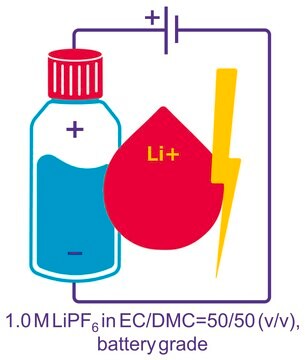266000
Lithium
ribbon, thickness × W 1.5 mm × 100 mm, 99.9% trace metals basis
Sinonimo/i:
Lithium foil
About This Item
Prodotti consigliati
Livello qualitativo
Saggio
99.9% trace metals basis
Stato
ribbon
Impiego in reazioni chimiche
reagent type: reductant
Caratteristiche più verdi
Design for Energy Efficiency
Learn more about the Principles of Green Chemistry.
sustainability
Greener Alternative Product
Resistività
9.446 μΩ-cm, 20°C
Spessore × larg.
1.5 mm × 100 mm
P. ebollizione
1342 °C (lit.)
Punto di fusione
180 °C (lit.)
Densità
0.534 g/mL at 25 °C (lit.)
applicazioni
battery manufacturing
Categoria alternativa più verde
Stringa SMILE
[Li]
InChI
1S/Li
WHXSMMKQMYFTQS-UHFFFAOYSA-N
Cerchi prodotti simili? Visita Guida al confronto tra prodotti
Descrizione generale
Applicazioni
Avvertenze
Danger
Indicazioni di pericolo
Consigli di prudenza
Classi di pericolo
Skin Corr. 1B - Water-react 1
Rischi supp
Codice della classe di stoccaggio
4.3 - Hazardous materials which set free flammable gases upon contact with water
Classe di pericolosità dell'acqua (WGK)
WGK 1
Punto d’infiammabilità (°F)
Not applicable
Punto d’infiammabilità (°C)
Not applicable
Dispositivi di protezione individuale
Eyeshields, Faceshields, Gloves, type P3 (EN 143) respirator cartridges
Scegli una delle versioni più recenti:
Possiedi già questo prodotto?
I documenti relativi ai prodotti acquistati recentemente sono disponibili nell’Archivio dei documenti.
I clienti hanno visto anche
Articoli
Professor Qiao’s laboratory lays out recent advances in conversion type lithium metal fluoride batteries. This review explores key concepts in developing electrochemically stable microstructures for wide Li-ion insertion channels.
Recent demand for electric and hybrid vehicles, coupled with a reduction in prices, has caused lithium-ion batteries (LIBs) to become an increasingly popular form of rechargeable battery technology.
Electrode Materials for Lithium Ion Batteries
Li-ion batteries are currently the focus of numerous research efforts with applications designed to reduce carbon-based emissions and improve energy storage capabilities.
Il team dei nostri ricercatori vanta grande esperienza in tutte le aree della ricerca quali Life Science, scienza dei materiali, sintesi chimica, cromatografia, discipline analitiche, ecc..
Contatta l'Assistenza Tecnica.




